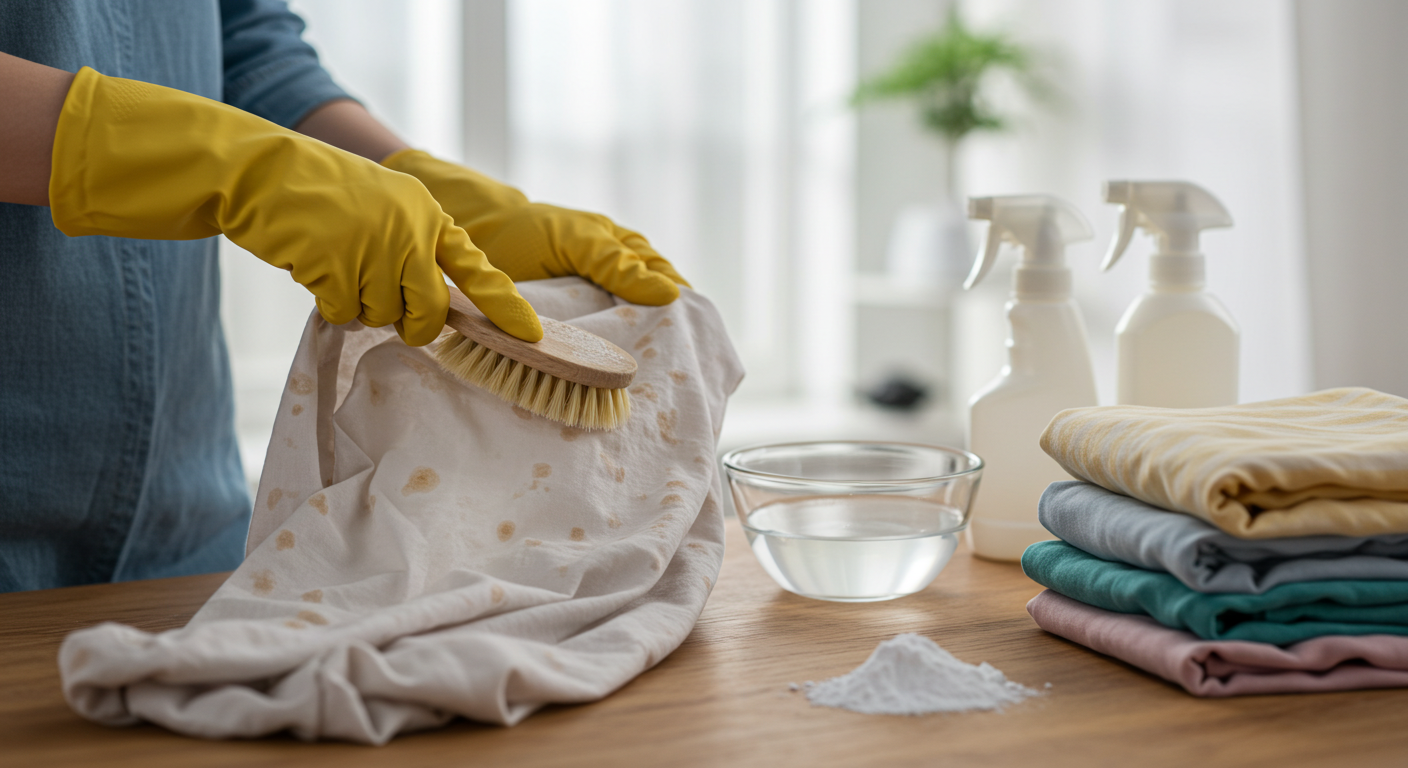How to Remove Mould From Fabric: A Complete Guide
Mould on fabric isn’t just unpleasant. It damages fibres, leaves stubborn stains, and can trigger allergies or breathing problems. Many people try to scrub it off, only to set the stain deeper or ruin the fabric. This guide explains exactly how to remove mould from fabric safely—no guesswork, no harsh chemicals that destroy your clothes or upholstery.
You’ll learn which fabrics are most at risk, what cleaning methods actually work, and how to stop mould coming back.
Mould Basics: What You Need to Know
Mould is a living organism. Its microscopic spores thrive in damp, dark places—like cupboards, bathrooms, or unventilated rooms.
When those spores land on fabric, they feed on dirt, sweat, and natural fibres. The result is dark spots, a musty smell, and eventually damaged material.
The first step is identifying what you’re dealing with:
- Surface mould is light and easy to remove.
- Black mould or ingrained mould has penetrated deeper into the fabric.
- Mildew looks similar but usually stays on the surface.
All respond to cleaning, but black mould may need stronger solutions or professional help.
Which Fabrics Are Most at Risk
Not all fabrics handle moisture the same way.
Natural fibres like cotton, wool, linen, and silk are highly absorbent, so they trap water and take longer to dry—perfect conditions for mould.
Synthetic fibres such as polyester or nylon resist moisture better but can still grow mould if left damp.
If you live in a humid climate or store clothes in poorly ventilated areas, focus on prevention. Choose mould-resistant fabrics for curtains, upholstery, or blinds whenever possible.
Pre-Cleaning Diagnosis
Before you start, check three things:
- Care label: If it says “dry clean only,” don’t wash it yourself.
- Colourfastness: Test a hidden patch with your chosen cleaner.
- Extent of moul: Small patches can be treated at home; heavy infestations may need a professional.
If the fabric is badly weakened or smells even after cleaning, it’s safer to dispose of it.
Safety and Setup
Removing mould releases spores into the air, so protect yourself and your space.
You’ll need:
- Gloves
- N95 mask or similar
- Safety glasses
- Soft brush
- Bucket
- HEPA vacuum (if available)
Work outdoors or in a well-ventilated area. Never shake mouldy fabric indoors.
Lay the item flat on a plastic sheet and brush off any loose spores. Vacuum gently using a HEPA filter to prevent spreading.
Dry Methods for Mild Cases
If the mould is light, start with dry cleaning steps before adding moisture.
- Brush both sides of the fabric outdoors.
- Leave it in direct sunlight for a few hours. UV rays help kill surface mould.
- For upholstery, cushions, or blinds, use a low-suction vacuum to lift spores.
Sometimes, this alone removes the smell and discolouration, especially if treated early.
Low-Moisture Treatments
For delicate or water-sensitive fabrics, try gentle, low-moisture options:
- Steam cleaning: Loosens spores without soaking the fibres.
- Dry vapour cleaning: Works well on upholstery or curtains.
- UV-C lamps: Can kill spores but must be used carefully and briefly.
Avoid over-wetting. Excess moisture can make mould return faster than before.
Wet Treatments: Soak and Clean
For washable items, soaking is the most effective way to remove mould and odour.
Step 1: Choose your solution
Use one of the following mixtures in a bucket or basin:
- White vinegar solution: One part vinegar to four parts water.
- Baking soda: Half a cup mixed into warm water for deodorising.
- Hydrogen peroxide (3%): Kills mould on white fabrics; test first.
- Enzyme detergent: Breaks down organic stains like mould and sweat.
- Oxygen bleach: For colour-safe items that can handle stronger cleaning.
Step 2: Soak
Immerse the fabric for 30–60 minutes. Agitate gently to loosen stains.
Step 3: Rinse
Rinse thoroughly in clean water to remove residue and spores.
Washing and Rinsing
Now wash the fabric as usual, but optimise your settings:
- Use the hottest water temperature that the care label allows.
- Add an enzyme detergent or a dose of oxygen bleach for stubborn stains.
- Never mix bleach and vinegar—they release toxic fumes.
- For delicates, hand-wash gently rather than machine-washing.
Repeat the wash if stains or odours persist. It’s safer than over-treating in one go.
Post-Clean Treatment and Deodorising
Even after cleaning, a faint musty smell may linger. Try these:
- Add baking soda to the final rinse to neutralise odours.
- Use activated charcoal sachets near the drying area.
- Spray a fabric-safe disinfectant or vinegar mist once dry.
- If possible, air the item outdoors for a few hours.
This step is key if you want to ensure your fabric is safe to wear after mould removal.
Drying and Sanitising
Sunlight is one of the best mould killers.
- Dry items outdoors in direct sunlight whenever possible.
- Turn them occasionally so all sides are exposed.
- For cloudy days, use a fan or a warm, dry room with low humidity.
- Only use a dryer when the care label permits, and never before the stain is gone—heat can fix it permanently.
For extra sanitising, use UV light briefly once the fabric is dry.
Special Use-Cases: Fabrics by Purpose
Upholstery and Sofas
Brush off spores, vacuum, then use a vinegar-and-water solution with a microfibre cloth.
Avoid over-wetting cushions. Let them dry fully in sunlight or use a dehumidifier.
Curtains and Blinds
Detach if possible. Soak fabric blinds or curtains in vinegar or enzyme detergent solution. Rinse well, air dry, then reinstall once fully dry.
Rugs and Carpets
Treat small patches with a baking soda and vinegar spray. For large areas, call a professional cleaner.
Delicate Fabrics (Silk, Wool, Velvet)
Avoid heavy soaking. Dab lightly with diluted vinegar or hydrogen peroxide.
If the mould persists, dry-clean rather than risk damage.
Sportswear and Synthetic Fabrics
Wash with enzyme detergent and warm water.
Add baking soda to remove odour and disinfect naturally.
Storage and Prevention
After removing mould, prevent it from coming back.
- Always dry fabrics completely before storing.
- Use breathable storage bags rather than plastic.
- Keep wardrobes clean, dry, and ventilated.
- Place moisture absorbers or silica gel near stored fabrics.
- Run a dehumidifier in humid rooms.
- Check stored fabrics every few months for early signs of mould.
You can also apply a mould-resistant fabric spray on curtains, upholstery, or cushions for extra protection.
Scenario Examples
Cotton Curtains in a Bathroom
Light mould on the bottom edges? Brush outside, soak in vinegar solution, wash hot, and dry in full sun.
Sofa in a Humid Flat
Use low-moisture steam, then wipe with vinegar. Follow with fan drying and a dehumidifier in the room.
Silk Dress from Storage
Spot clean gently with diluted hydrogen peroxide, rinse, then air dry in shade. For persistent stains, send to a professional cleaner.
These examples help you apply the right approach for each fabric.
When to Throw It Away
Sometimes the damage is beyond repair. Discard the item when:
- The fabric tears easily or smells even after multiple washes.
- Black mould has spread through thick layers.
- You have respiratory sensitivities or allergies.
It’s better to protect your health than save a badly contaminated item.
When to Call a Professional
If the mould covers large upholstery, rugs, or blinds—or you notice regrowth within days—hire a professional.
Experts use HEPA filtration, controlled drying, and safe disinfectants that won’t weaken fabric.
Look for certified mould remediation companies with fabric-specific experience.

Glossary and Quick Reference
- Mould vs Mildew: Mould penetrates fabric; mildew stays on the surface.
- Enzyme cleaner: Breaks down organic matter like mould and sweat.
- Oxygen bleach: Non-chlorine alternative safe for colours.
- HEPA filter: Captures fine spores during vacuuming.
- UV-C treatment: Uses light to sterilise surfaces.
Keep this glossary handy for quick checks during cleaning.
FAQs
Will the mould stain disappear completely?
Usually yes, but older stains may fade rather than vanish.
Is it safe to wear after cleaning?
Yes—if washed thoroughly, dried in sun, and no odour remains.
Can I freeze mouldy clothes?
Freezing stops growth but doesn’t kill spores. Always wash after thawing.
How can I remove mildew from fabric?
Use the same vinegar or baking soda methods; mildew is less aggressive than mould.
How do I disinfect fabric after mould?
Spray lightly with diluted hydrogen peroxide or vinegar after washing.
Conclusion
You can remove mould from almost any fabric with the right steps: brush, treat, wash, dry, and prevent.
Act quickly, use safe cleaners, and make sure fabrics are completely dry before storing.
By combining natural methods like vinegar, baking soda, and sunlight with careful handling, you protect your health, save your fabrics, and prevent mould from returning.






